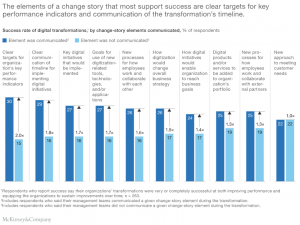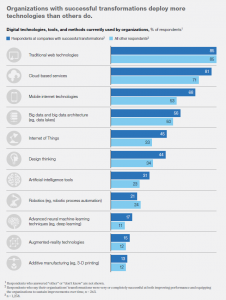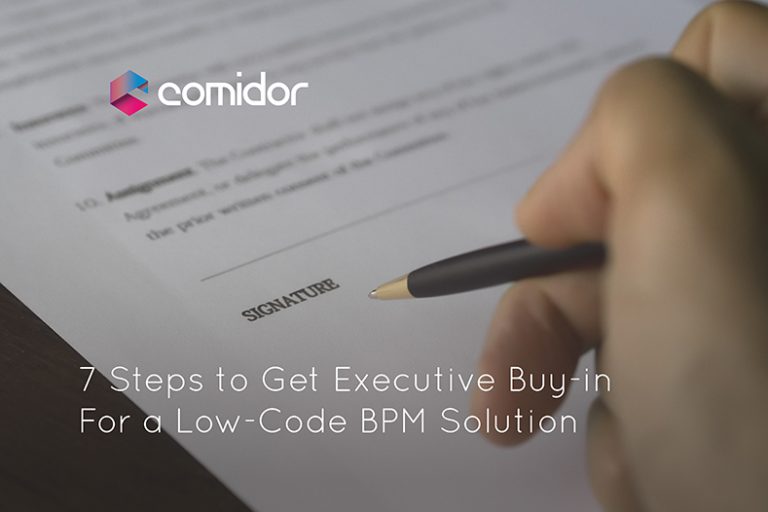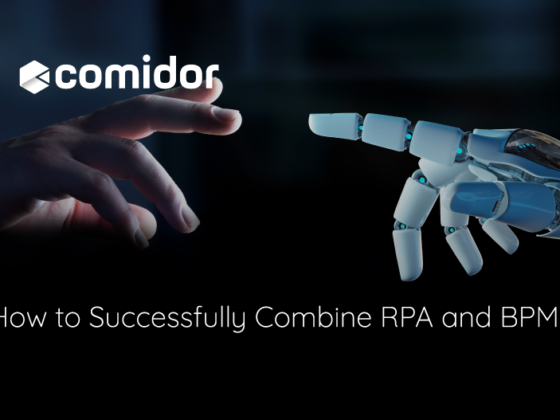To get an executive buy-in, starts by never talking to an executive about Low-Code BPM. Instead, talk about what they care about : Results. Outcomes. Impact. Value.
Middle ranks managers and organizations’ prosperity
Organizations adapt slowly to change, unless managers in the middle ranks, like a project manager, business analyst or an operational manager, identify and promote the need for change.
People at that level gather valuable business intelligence from direct contact with customers, suppliers, colleagues, and even competitors. They’re in a position to foresee when the business falls behind the market. Moreover, they can detect early signs that a partnership with existing legacy system vendor won’t work out (see our article on Legacy Systems Modernization). According to McKinsey Global Survey on digital transformations (Graph.1), the success rate of the transformation efforts is positively correlated with the management team’s communication of a given change-story element during the transformation.
Emphasize “What’s in it for the Business”

Graph.1: Unlocking success in digital transformations
Don’t focus on the Low-Code BPM system
While you are researching the market, contacting one solution vendor after the other, doing platform trials and demos, trying to understand what solution could best solve your business pain, you become prone to get excited from the features and technical details of a system. Thus, a conversation with your boss on those features and details is to begin.
Don’t do this. Your senior management team (SMT) really isn’t interested in finding out how any systems work. They don’t attach importance to what new features systems bring to the market or what they can do. Giving them this information will switch them off before they get started. The SMT is interested in business cases for investment in projects and systems which solve a problem. Cost savings, productivity improving, faster app delivery are some problems the SMT wants to solve. They don’t care about the nuts and bolts of how you are proposing to do this, at all. Instead, they do want to know that you will do it, and what resulting benefits you will bring.
Don’t focus on non-strategic benefits
Low-Code BPM, like Comidor, which is one of the best BPM solutions of 2019 according to SoftwareWorld, can deliver plentiful results at a lot of organization’s levels.
If you are an Operational Manager, installing a new easy-to-use, easy-to-customize Low-Code BPM system, will undoubtedly make your life a great deal easier. But, explaining this to the SMT will not make them reach for their cheque books (metaphorically). Oddly making your life easier is not at the top of the SMT’s list of concerns. Therefore, it is better not to include it in your business case. Instead of that, think how a benefit for you, might result in a strategic benefit for the whole organization.
Step #1: Simplicity is key – so be result specific
One of the reasons that low-code BPM systems make our lives easier is the time and cost saving. As well as saving a Quality or Operational Manager’s time, a BPM system also saves the time of all its end users. Now, it is more likely to get the interest of the leadership team. How? By explaining for example, how each time someone makes a request, they will save at least 15 minutes. As this is an action repeated 10 times a day, by 1,000 employees – that is 150,000 minutes or 2,500 hours saved each day. This procedure results to millions of dollars of efficiency savings each day. Also, the quantification of the cost of inactivity and your business opportunity cost is equally important. Consequently, be prepared to have a benefit checklist ready to support your case in your discussions with your boss.
Step #2: Implementation risk – address outcomes and failure fears
Strategic cross-organizational low-code BPM implementations often involve political battles in terms of how the business will operate tomorrow. The fear of the unknown is a powerful and dangerous force. People resist the change because of the fear of complicating old processes (the devil we know) with new technology. New technology may hinder team’s day-to-day tasks or lead to new digital failures (Graph.2). Identify, communicate and commit the team and the resources needed to implement the solution. Finally, set up a decision-making support plan. In this way, the management has full control on approving each targeted milestone.

Graph.2: Gartner “Make Legal Digital-Ready”
Step #3: Target the topics your business executives are invested in
Before approaching a prospective sponsor for your low-code BPM solution need, have an idea about their priorities, and the critical points of importance. Target the topics they are invested in, and the issues they care about more than other execs of the leadership team do.
Your HR director may focus on managing employee on-boarding and spreading teams across offices in different geographic regions. The major concern for your head of operations may be to control risk. On the other hand, your director of customer success may envisage a platform that standardizes service levels and reduces time to market cycle. A platform that results in happy clients.
Step #4: The power of example – Competition pressure
The management executives identify themselves as business leaders. They assume themselves as the ones who should accept the responsibility and the opportunity to take their business forward and change their business model. Two thirds of surveyed CEO’s in Gartner’s latest insight report “Make Legal Digital-Ready”, said they are constantly adapting to change (Graph.3).
There is no better way to catch their attention than by presenting examples of successful low-code BPM projects in your sector. In other words, demonstrating competitors that are riding the low-code BPM wave and transforming their way of doing business, attracts the management executives’ attention. Connect the dots in their new products, services, client satisfaction and ultimately market share with the role of BPM solution in your competitors’ growth story.

Graph.3: Gartner “Make Legal Digital-Ready”
Step #5: Involve Other believers-build a “coalition”
The more people you get in your corner, supporting your ideas and providing first-hand experiences, the more urgent and legitimate the initiative seems. Your BPM “coalition” should include those professionals with a mix of organizational credibility and executional expertise. This likely means enlisting IT leaders, managers, and some process participants, too. Building a “coalition” generates organizational buy-in more quickly and on a larger scale. This happens because more people contribute their own energy and resources. For instance, one “coalition member” might have access to important data to support your business case. Another might have a good personal relationship with one of the top managers you’re trying to present your low-code BPM pitch to. By recognizing these advantages, you become more successful in supporting your business case.
Step #6: Bring in an Expert
Since we are in the process of doing something for first time in your organization, sometimes you need the support of an outside expert to break through a wall. An outsider, that could be a digital transformation team of consultants, has the independence to challenge traditional thinking and break down paradigms. Use those experts to send a clear message on market awareness and trends and bring executives to their own aha moments regarding change management.
Step #7: Get the Timing Right
It’s very crucial to find the right moment to raise your ideas. That moment might be when organizational priorities shift, when new executives come on board, or when business crisis occurs. Successful project proposals are reported when they are related to greater sensitivity than others to timing. You should notice when more people begin to care about a larger topic or trend, related to your idea to “catch the wave.”
In addition to keeping a close eye on larger trends and events, it’s important to be mindful of deadlines. If an idea relates directly to an imminent product launch or software release, by all means speak up. Now is the time to be heard.
As you support your business leaders in their efforts to transform the business, you find your business culture becoming more accepting to implementing those necessary systems. This business culture optimizes the business function as a whole. See (Graph.4) McKinsey Global Survey on digital transformations.

Graph.4: Unlocking success in digital transformations
Conclusion
Sell the opportunity to leave a legacy. You will find out that many executives are passionate about what they do. They really care about making a lasting impact on their organization. Implementing a process improvement culture makes a real difference to business teams and to the success of an organization. Execs are about to leave a legacy with the support of engaged teams and professionals, who are executing processes aligned to the business strategy like yourself.






